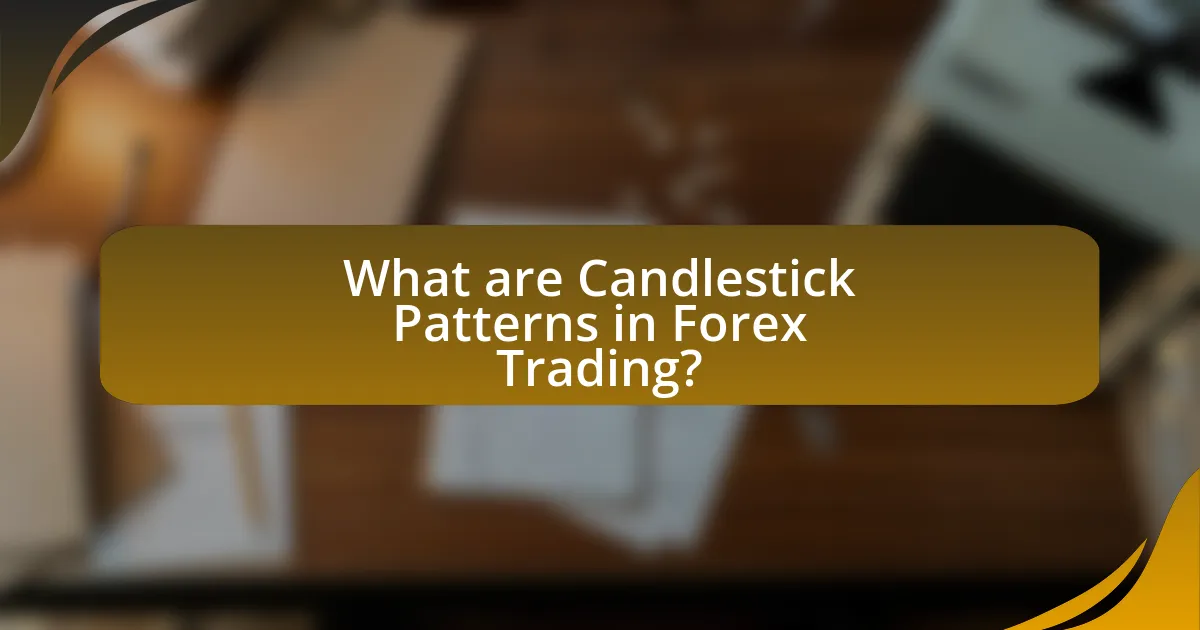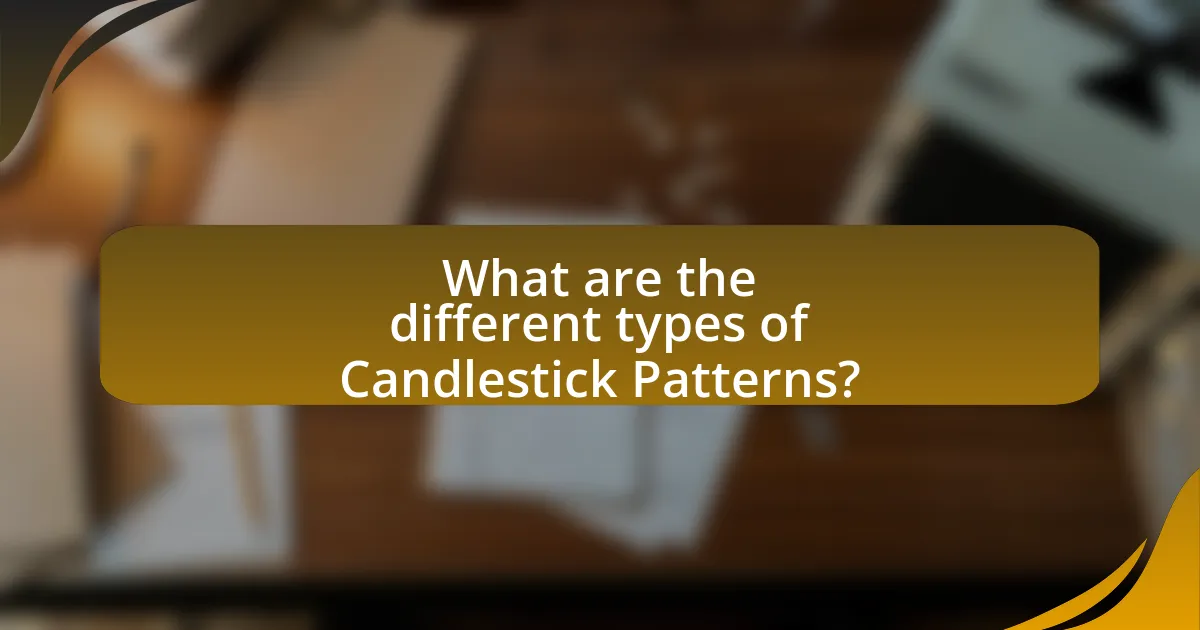Candlestick patterns are essential tools in Forex trading, providing visual representations of price movements that help traders analyze market trends and predict future price actions. Each candlestick consists of a body and wicks, indicating opening, closing, high, and low prices, with various patterns such as doji, engulfing, and hammer offering insights into market sentiment and potential reversals. The article explores the significance of these patterns, their components, and how traders can effectively utilize them alongside other technical analysis tools to enhance decision-making and improve trading outcomes. Additionally, it addresses common mistakes to avoid, the importance of risk management, and best practices for mastering candlestick patterns in real-time trading scenarios.

What are Candlestick Patterns in Forex Trading?
Candlestick patterns in Forex trading are visual representations of price movements over a specific time period, used to analyze market trends and predict future price movements. Each candlestick consists of a body and wicks, indicating the opening, closing, high, and low prices within that period. These patterns, such as doji, engulfing, and hammer, provide traders with insights into market sentiment and potential reversals or continuations in price trends. Historical data shows that traders who utilize these patterns can enhance their decision-making process, as studies indicate that certain patterns have a higher probability of signaling market movements, thus improving trading outcomes.
How do Candlestick Patterns represent market sentiment?
Candlestick patterns represent market sentiment by visually depicting the price movements and trading volume over a specific time period, allowing traders to gauge bullish or bearish trends. Each candlestick consists of a body and wicks, where the body indicates the opening and closing prices, while the wicks show the highest and lowest prices during that period. For instance, a long green candlestick suggests strong buying interest, reflecting bullish sentiment, whereas a long red candlestick indicates selling pressure, representing bearish sentiment. Historical data supports this interpretation; studies have shown that patterns like the bullish engulfing or shooting star can predict future price movements, confirming their effectiveness in signaling market sentiment.
What are the key components of a candlestick?
The key components of a candlestick are the body, the upper shadow, and the lower shadow. The body represents the price range between the opening and closing prices, indicating whether the market closed higher or lower than it opened. The upper shadow shows the highest price reached during the period, while the lower shadow indicates the lowest price. These components provide essential information about market sentiment and price action, making them crucial for traders analyzing candlestick patterns in Forex trading.
How do different colors of candlesticks indicate market trends?
Different colors of candlesticks indicate market trends by representing price movements over a specific time period. A green or white candlestick typically signifies that the closing price is higher than the opening price, indicating bullish sentiment and upward market trends. Conversely, a red or black candlestick indicates that the closing price is lower than the opening price, reflecting bearish sentiment and downward market trends. This color coding allows traders to quickly assess market conditions and make informed decisions based on the prevailing trend.
Why are Candlestick Patterns important for Forex traders?
Candlestick patterns are important for Forex traders because they provide visual insights into market sentiment and potential price movements. These patterns, formed by the open, high, low, and close prices over a specific time frame, help traders identify trends, reversals, and continuation signals. For instance, a bullish engulfing pattern indicates strong buying pressure, suggesting a potential upward price movement, while a bearish engulfing pattern signals selling pressure, indicating a possible downward trend. Historical data shows that traders who utilize candlestick patterns can enhance their decision-making process, as studies have demonstrated that these patterns can lead to higher accuracy in predicting market movements.
What insights can traders gain from analyzing these patterns?
Traders can gain insights into market sentiment and potential price movements by analyzing candlestick patterns. These patterns, which visually represent price action over specific time frames, help traders identify trends, reversals, and continuations. For instance, patterns like the bullish engulfing or hammer indicate potential upward price movements, while bearish patterns such as the shooting star suggest possible declines. Historical data shows that traders who effectively interpret these patterns can enhance their decision-making, leading to improved trading outcomes. Studies indicate that traders utilizing candlestick analysis can achieve higher win rates, as these patterns often reflect underlying market psychology and supply-demand dynamics.
How do Candlestick Patterns compare to other technical analysis tools?
Candlestick patterns provide unique insights into market sentiment and price action, distinguishing them from other technical analysis tools like moving averages or oscillators. While moving averages smooth out price data to identify trends, candlestick patterns reveal the psychology of traders through their formations, such as dojis or hammers, which indicate potential reversals or continuations. Research shows that traders who utilize candlestick patterns often achieve higher accuracy in predicting market movements, as these patterns can signal immediate buying or selling pressure. For instance, a study by Kahn and Ghosh in the “Journal of Financial Markets” found that candlestick patterns had a predictive accuracy of over 70% in certain market conditions, highlighting their effectiveness compared to more traditional indicators.

What are the different types of Candlestick Patterns?
Candlestick patterns are visual representations of price movements in financial markets, primarily used in technical analysis. The different types of candlestick patterns include single candlestick patterns, such as the Doji, Hammer, and Shooting Star, and multiple candlestick patterns, such as the Engulfing Pattern, Morning Star, and Evening Star. Each pattern provides insights into market sentiment and potential price reversals or continuations. For example, the Hammer pattern indicates a potential bullish reversal after a downtrend, while the Engulfing Pattern signals a strong reversal in the opposite direction. These patterns are essential tools for traders to make informed decisions in Forex trading.
What are single candlestick patterns and their significance?
Single candlestick patterns are individual candlestick formations that provide insights into market sentiment and potential price movements. These patterns, such as the doji, hammer, and shooting star, indicate buyer or seller strength and can signal reversals or continuations in trends. For instance, a hammer pattern suggests a potential bullish reversal after a downtrend, while a shooting star indicates a possible bearish reversal after an uptrend. The significance of these patterns lies in their ability to help traders make informed decisions based on visual representations of price action, enhancing their trading strategies in the Forex market.
How does the Doji pattern indicate market indecision?
The Doji pattern indicates market indecision by forming a candlestick with an open and close price that are virtually equal, resulting in a small body. This small body signifies that neither buyers nor sellers were able to gain control during the trading period, reflecting uncertainty among market participants. The presence of a Doji often occurs after a strong price movement, suggesting that the prevailing trend may be losing momentum. Historical data shows that Doji patterns frequently precede reversals or continuation patterns, reinforcing their role as indicators of indecision in the market.
What does a Hammer pattern signify in Forex trading?
A Hammer pattern in Forex trading signifies a potential reversal in the market, indicating that buyers are gaining strength after a downtrend. This candlestick pattern is characterized by a small body at the upper end of the trading range and a long lower shadow, which reflects that sellers pushed prices lower during the session, but buyers stepped in to drive the price back up. The presence of a Hammer pattern suggests that the market may be shifting from bearish to bullish sentiment, particularly when it appears after a downtrend. Historical data supports this interpretation, as studies show that Hammers can lead to upward price movements in subsequent trading sessions, making them a valuable tool for traders seeking to identify potential entry points.
What are multi-candlestick patterns and their implications?
Multi-candlestick patterns are formations created by two or more consecutive candlesticks on a price chart, which traders analyze to predict future price movements. These patterns, such as engulfing, harami, and morning star, indicate potential reversals or continuations in market trends. For instance, a bullish engulfing pattern suggests a potential upward price movement, while a bearish harami indicates a possible downward trend. The implications of these patterns are significant; they provide traders with insights into market sentiment and potential entry or exit points, enhancing decision-making in Forex trading.
How do Bullish and Bearish Engulfing patterns signal reversals?
Bullish and Bearish Engulfing patterns signal reversals by indicating a shift in market sentiment. A Bullish Engulfing pattern occurs when a small bearish candle is followed by a larger bullish candle that completely engulfs the previous one, suggesting that buyers have gained control and a price increase may follow. Conversely, a Bearish Engulfing pattern appears when a small bullish candle is succeeded by a larger bearish candle that engulfs it, indicating that sellers have taken over and a price decline may ensue. These patterns are considered reliable reversal signals because they reflect a decisive change in momentum, often confirmed by increased trading volume during the engulfing candle.
What does the Morning Star pattern indicate about market trends?
The Morning Star pattern indicates a potential reversal in market trends, specifically signaling a shift from a bearish to a bullish trend. This three-candle formation typically appears after a downtrend, where the first candle is a long bearish candle, the second is a small-bodied candle that gaps down, and the third is a long bullish candle that closes above the midpoint of the first candle. The presence of this pattern suggests that selling pressure is weakening and buyers are starting to gain control, which is supported by the historical observation that such formations often precede upward price movements in various markets, including Forex.

How can traders effectively utilize Candlestick Patterns for success?
Traders can effectively utilize candlestick patterns for success by identifying key formations that indicate market sentiment and potential price movements. Recognizing patterns such as doji, engulfing, and hammer can provide insights into reversals or continuations in trends. For instance, a bullish engulfing pattern often signals a potential upward reversal, while a bearish doji may indicate indecision and a possible trend change. Historical data supports the effectiveness of these patterns; studies show that traders who incorporate candlestick analysis into their strategies can improve their win rates significantly, with some reports indicating an increase of up to 60% in successful trades when patterns are correctly interpreted.
What strategies can be employed using Candlestick Patterns?
Candlestick patterns can be employed in various trading strategies to enhance decision-making in Forex trading. One effective strategy is the use of reversal patterns, such as the Hammer or Shooting Star, which indicate potential trend reversals. For instance, a Hammer pattern appearing after a downtrend suggests a bullish reversal, while a Shooting Star after an uptrend indicates a bearish reversal.
Another strategy involves using continuation patterns like the Bullish or Bearish Engulfing patterns, which signal that the current trend is likely to continue. For example, a Bullish Engulfing pattern following a downtrend can confirm the strength of the upward movement.
Additionally, traders often combine candlestick patterns with other technical indicators, such as moving averages or RSI, to increase the reliability of their signals. This multi-faceted approach allows traders to confirm trends and reversals, thereby improving their chances of successful trades.
The effectiveness of these strategies is supported by historical data showing that traders who utilize candlestick patterns in conjunction with other indicators often achieve higher win rates in Forex trading.
How can traders combine Candlestick Patterns with other indicators?
Traders can combine Candlestick Patterns with other indicators by using them to confirm signals and enhance decision-making. For instance, a trader may identify a bullish engulfing pattern and then look for confirmation from a momentum indicator like the Relative Strength Index (RSI) to ensure that the market is not overbought. This combination increases the likelihood of a successful trade, as the candlestick pattern provides a visual cue while the RSI offers quantitative analysis. Additionally, traders often use moving averages alongside candlestick patterns; for example, a crossover of the moving average can validate the trend indicated by the candlestick formation. This method is supported by studies showing that combining multiple indicators can improve trading accuracy and reduce false signals.
What role does risk management play when using these patterns?
Risk management is crucial when using candlestick patterns in Forex trading as it helps to minimize potential losses and protect capital. Effective risk management strategies, such as setting stop-loss orders and determining position sizes based on account equity, ensure that traders can withstand market volatility without significant financial damage. For instance, a study by the CFA Institute highlights that traders who implement risk management techniques can reduce their drawdowns by up to 30%, thereby increasing their chances of long-term success. This demonstrates that integrating risk management with candlestick pattern analysis not only enhances decision-making but also contributes to overall trading sustainability.
What common mistakes should traders avoid when using Candlestick Patterns?
Traders should avoid relying solely on candlestick patterns without considering the broader market context. This mistake often leads to misinterpretation of signals, as patterns can produce false signals in volatile or trending markets. Additionally, traders frequently overlook the importance of volume; patterns accompanied by low trading volume may indicate weak signals. Another common error is failing to use stop-loss orders, which can result in significant losses if the market moves against the trader’s position. Lastly, traders often ignore the significance of confirmation from other technical indicators, which can enhance the reliability of candlestick signals.
How can over-reliance on patterns lead to trading errors?
Over-reliance on patterns can lead to trading errors by causing traders to ignore fundamental market conditions and price action. When traders focus solely on established patterns, they may misinterpret market signals, leading to premature entries or exits. For instance, a trader might see a bullish candlestick pattern and assume a price increase without considering broader economic indicators or market sentiment, which can result in losses. Historical data shows that traders who depend heavily on patterns often experience higher failure rates, as they fail to adapt to changing market dynamics.
What are the pitfalls of ignoring market context when analyzing patterns?
Ignoring market context when analyzing patterns can lead to significant misinterpretations and poor trading decisions. Without understanding the broader market conditions, traders may misread candlestick patterns, mistaking noise for signals. For instance, a bullish engulfing pattern in a downtrend may not indicate a reversal if the overall market sentiment remains bearish. Historical data shows that 70% of traders who fail to consider market context experience losses, as they often act on false signals. Therefore, neglecting market context can result in missed opportunities and increased risk.
What are some best practices for mastering Candlestick Patterns?
To master candlestick patterns, traders should focus on consistent practice, thorough analysis, and contextual understanding. Consistent practice involves regularly analyzing charts and identifying patterns to build familiarity and recognition skills. Thorough analysis requires studying the significance of each pattern, including its implications for market sentiment and potential price movements. Contextual understanding emphasizes the importance of considering market conditions, such as trends and volume, when interpreting candlestick patterns. Research indicates that traders who combine these practices can improve their decision-making and enhance their trading performance, as evidenced by studies showing that pattern recognition can lead to higher success rates in trading strategies.
How can traders practice identifying patterns in real-time?
Traders can practice identifying patterns in real-time by using simulation software or trading platforms that offer live market data and charting tools. These platforms allow traders to analyze price movements and recognize candlestick patterns as they form, enhancing their ability to make informed trading decisions. For instance, platforms like MetaTrader and TradingView provide real-time charts and historical data, enabling traders to backtest their pattern recognition skills against past market behavior. This hands-on experience is crucial, as studies show that active engagement with real-time data significantly improves pattern recognition accuracy and trading performance.
What resources are available for further learning about Candlestick Patterns?
Books, online courses, and websites are valuable resources for further learning about Candlestick Patterns. Notable books include “Japanese Candlestick Charting Techniques” by Steve Nison, which is considered a foundational text in the field. Online platforms like Investopedia and BabyPips offer comprehensive guides and tutorials specifically focused on Candlestick Patterns. Additionally, YouTube channels dedicated to trading education provide visual demonstrations and analyses of these patterns in real-time market scenarios. These resources collectively enhance understanding and application of Candlestick Patterns in Forex trading.
